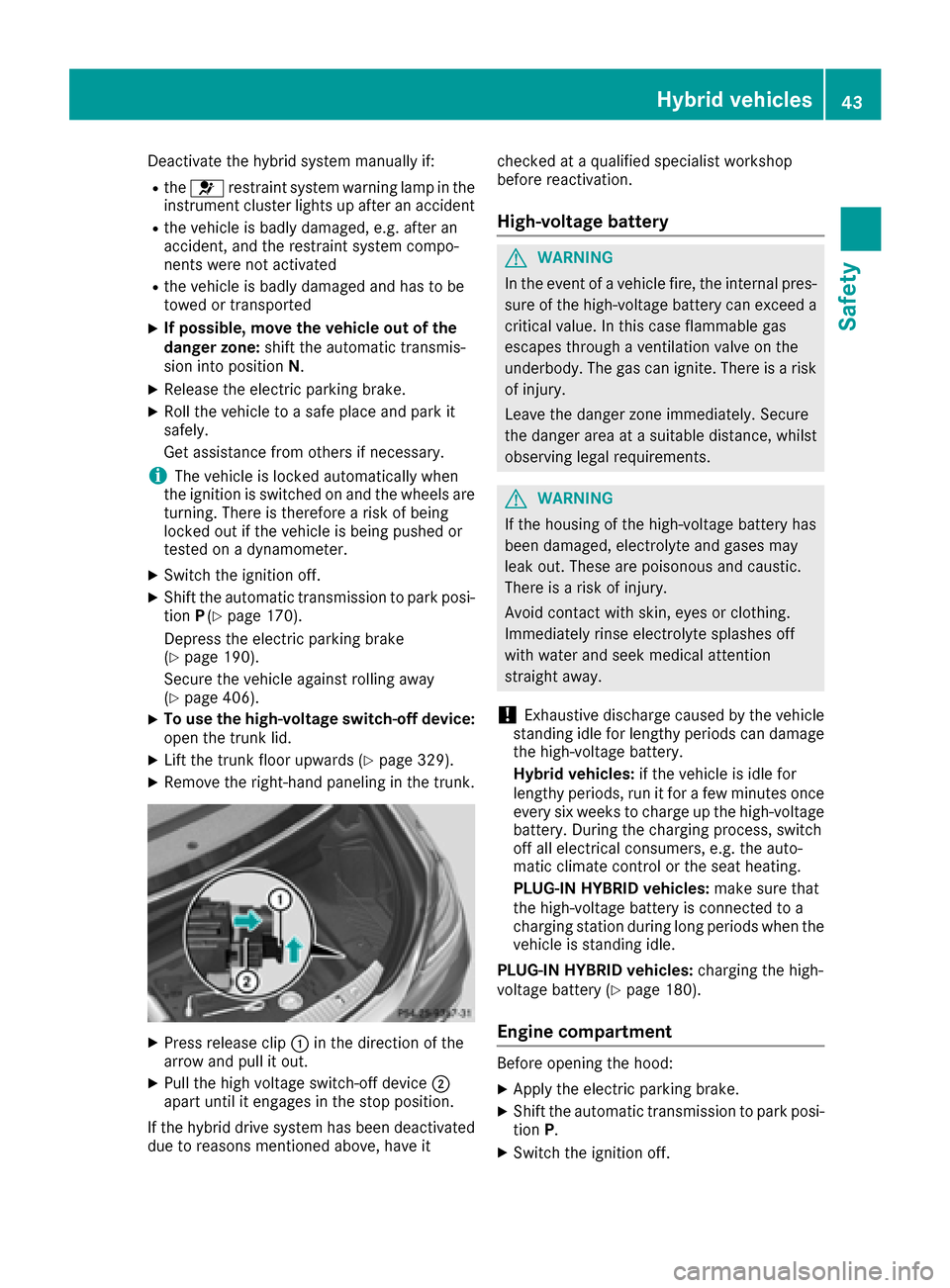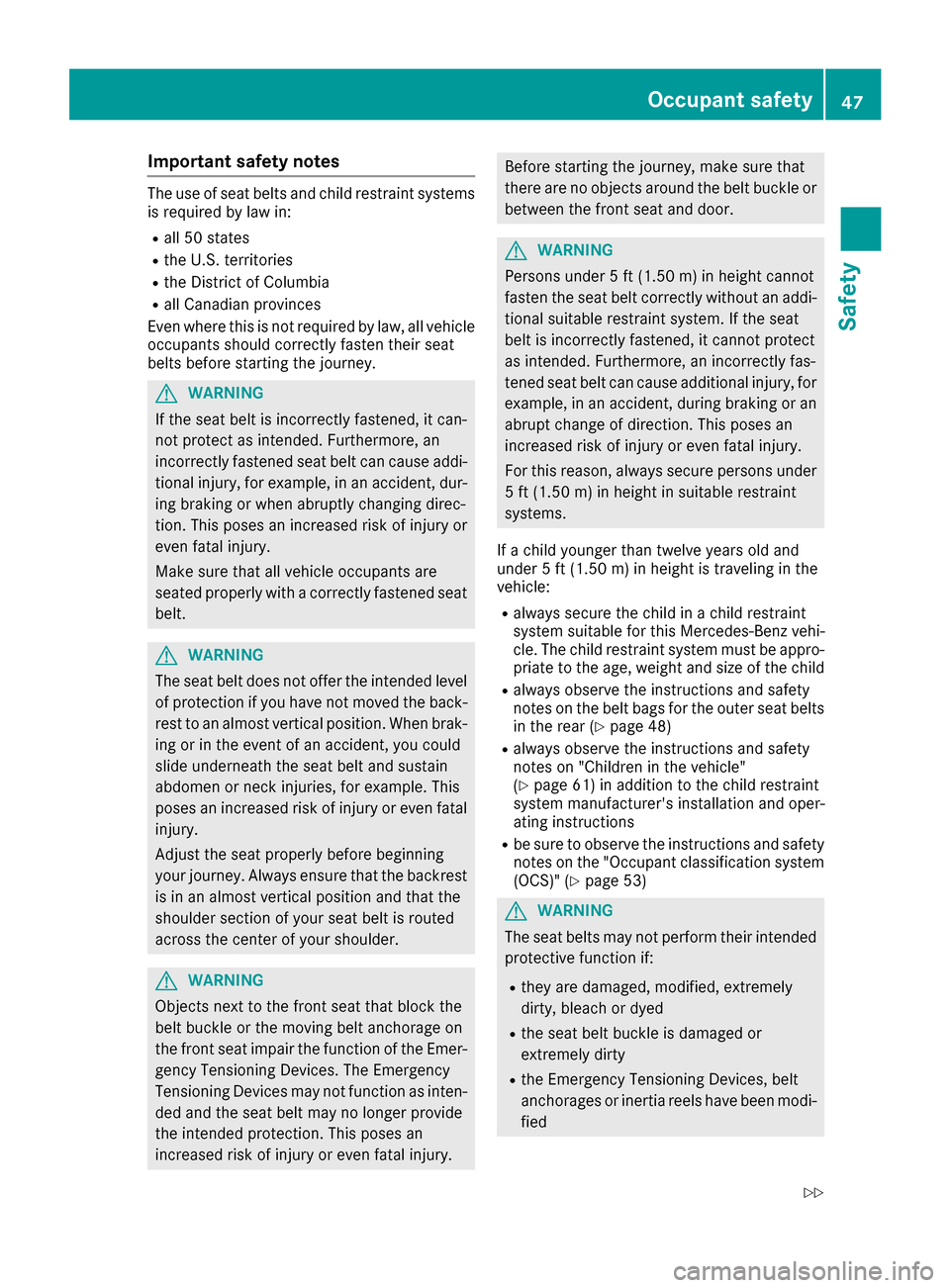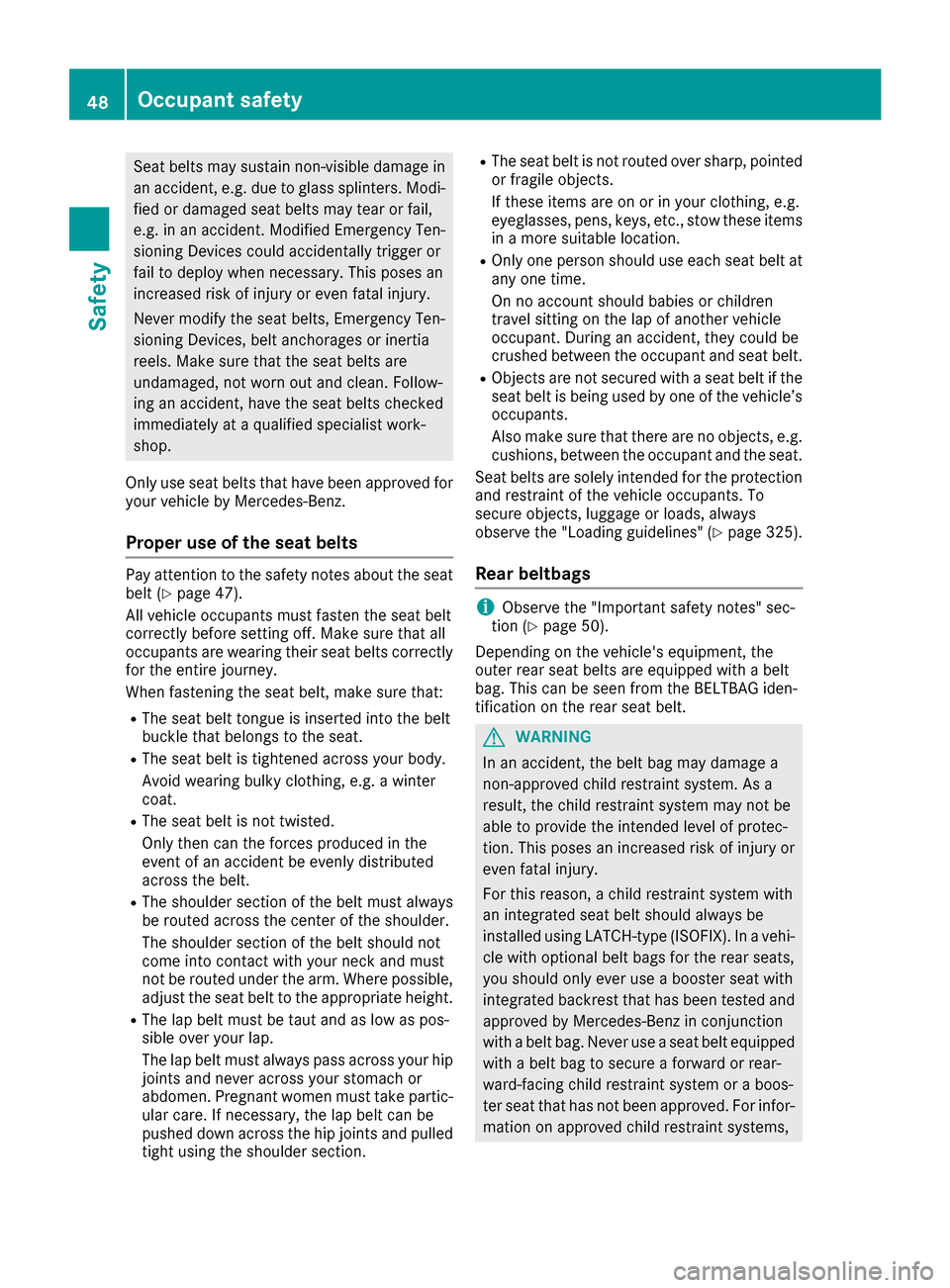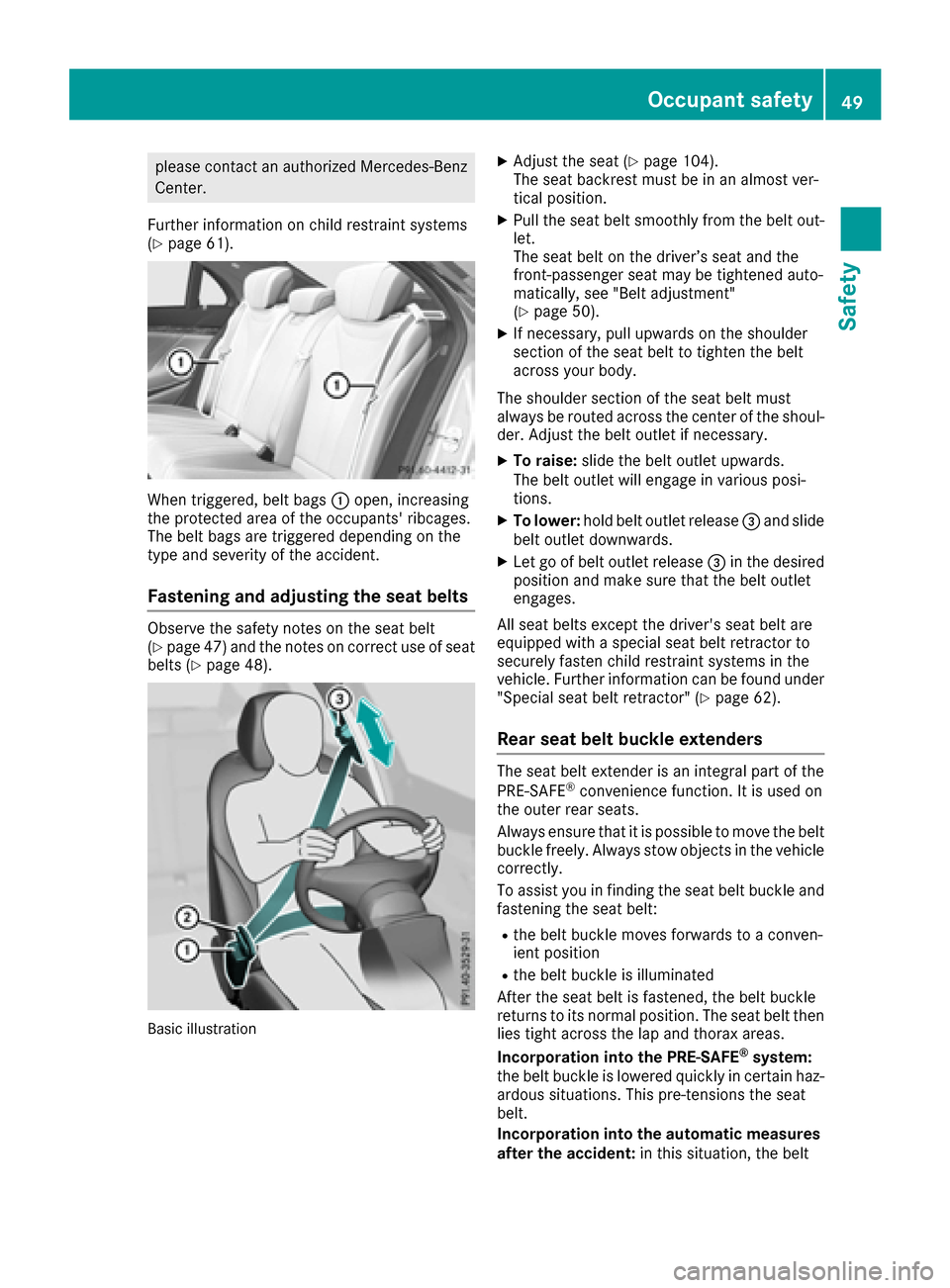2016 MERCEDES-BENZ S-Class SEDAN ECU
[x] Cancel search: ECUPage 30 of 438

the vehicle's high-voltage electrical system
checked by a qualified specialist workshop.
The components of the vehicle's high-voltage
electrical system are marked with yellow warn-
ing stickers. The cables of the vehicle's high-
voltage electrical system are orange in color.
Vehicles with an electric motor generate much
less driving noise than vehicles with internal
combustion engines. As a result, your vehicle
may not be heard by other road users in certain
situations. This can happen, for example, when
you are parking and your vehicle is not seen by
other road users. This requires you to adopt a
particularly anticipatory driving style, as it is
necessary to allow for the possibility that other
road users may behave erratically.
Declarations of conformity
Vehicle components which receive
and/or transmit radio waves
USA: "The wireless devices of this vehicle com-
ply with Part 15 of the FCC Rules. Operation is
subject to the two following two conditions: 1)
These devices may not cause harmful interfer-
ence, and 2) These devices must accept any
interference received, including interference
that may cause undesired operation. Changes
or modifications not expressly approved by the
party responsible for compliance could void the
user’s authority to operate the equipment."
Canada: "The wireless devices of this vehicle
comply with Industry Canada license-exempt
RSS standard(s). Operation is subject to the fol-
lowing two conditions: (1) These devices may
not cause interference, and (2) These devices
must accept any interference, including inter-
ference that may cause undesired operation of
the device."
Diagnostics connection
The diagnostics connection is only intended for
the connection of diagnostic equipment at a
qualified specialist workshop.
GWARNING
If you connect equipment to the diagnostics
connection in the vehicle, it may affect the
operation of the vehicle systems. As a result,
the operating safety of the vehicle could be
affected. There is a risk of an accident.
Do not connect any equipment to a diagnos-
tics connection in the vehicle.
GWARNING
Objects in the driver's footwell can restrict the pedal travel or obstruct a depressed pedal.
The operating and road safety of the vehicle is
jeopardized. There is a risk of an accident.
Make sure that all objects in the vehicle are
stowed correctly, and that they cannot enter
the driver's footwell. Install the floormats
securely and as specified in order to ensure
sufficient clearance for the pedals. Do not use
loose floormats and do not place floormats on
top of one another.
!If the engine is switched off and equipment
on the diagnostics connection is used, the
starter battery may discharge.
Connecting equipment to the diagnostics con-
nection can lead to emissions monitoring infor-
mation being reset, for example. This may lead
to the vehicle failing to meet the requirements of
the next emissions test during the main inspec-
tion.
Qualified specialist workshop
An authorized Mercedes-Benz Center is a quali-
fied specialist workshop. It has the necessary
specialist knowledge, tools and qualifications to
correctly carry out the work required on your
vehicle. This is especially the case for work rel-
evant to safety.
Observe the notes in the Maintenance Booklet.
Always have the following work carried out at an
authorized Mercedes-Benz Center:
Rwork relevant to safety
Rservice and maintenance work
Rrepair work
Ralterations, installation work and modifica-
tions
Rwork on electronic components
Rwork on the hybrid drive system
28Introduction
Page 31 of 438

Correct use
If you remove any warning stickers, you or oth-
ers could fail to recognize certain dangers.
Leave warning stickers in position.
Observe the following information when driving
your vehicle:
Rthe safety notes in this manual
Rthe vehicle technical data
Rtraffic rules and regulations
Rlaws and safety standards pertaining to motor
vehicles
Problems with your vehicle
If you should experience a problem with your
vehicle, particularly one that you believe may
affect its safe operation, we urge you to contact
an authorized Mercedes-Benz Center immedi-
ately to have the problem diagnosed and recti-
fied. If the problem is not resolved to your sat-
isfaction, please discuss the problem again with
a Mercedes-Benz Center or contact us at one of
the following addresses.
In the USA
Customer Assistance Center
Mercedes-Benz USA, LLC
One Mercedes Drive
Montvale, NJ 07645-0350
In Canada
Customer Relations Department
Mercedes-Benz Canada, Inc.
98 Vanderhoof Avenue
Toronto, Ontario M4G 4C9
Reporting safety defects
USA only:
The following text is published as required of
manufacturers under Title 49, Code of U.S. Fed-
eral Regulations, Part 575 pursuant to the
"National Traffic and Motor Vehicle Safety Act of 1966".
If you believe that your vehicle has a defect
which could cause a crash or could cause injury
or death, you should immediately inform the
National Highway Traffic Safety Administration
(NHTSA) in addition to notifying Mercedes-Benz
USA, LLC. If NHTSA receives similar complaints, it may
open an investigation, and if it finds that a safety
defect exists in a group of vehicles, it may order
a recall and remedy campaign. However, NHTSA
cannot become involved in individual problems
between you, your dealer, or Mercedes-Benz
USA, LLC.
To contact NHTSA, you may call the Vehicle
Safety Hotline toll-free at
1-888-327-4236(TTY: 1-800-424-9153
);go to
http://www.safercar.gov ; or write to: Admin-
istrator, NHTSA, 400 Seventh Street, SW.,
Washington, DC 20590.
You can also obtain other information about
motor vehicle safety from
http://www.safercar.gov
Limited Warranty
!
Follow the instructions in this manual about
the proper operation of your vehicle as well as
about possible vehicle damage. Damage to
your vehicle that arises from culpable contra-
ventions against these instructions is not cov-
ered either by the Mercedes-Benz Limited
Warranty or by the New or Used-Vehicle War-
ranty.
QR codes for the rescue card
The QR codes are secured in the fuel filler flap
and on the opposite side on the B-pillar. In the
event of an accident, rescue services can use
the QR code to quickly find the appropriate res-
cue card for your vehicle. The current rescue
card contains the most important information
about your vehicle in a compact form, e.g. the
routing of the electric cables.
You can find more information under http://
portal.aftersales.i.daimler.com/public/
content/asportal/en/communication/
informationen_fuer/QRCode.html.
Data stored in the vehicle
Data storage
A wide range of electronic components in your
vehicle contain data memories.
Introduction29
Z
Page 36 of 438

Warning and indicator lamps
FunctionPage
:!ABS316
;åESP®OFF317
÷ESP®317
=#Turn signal, left131
?LLow-beam headlamps131
AKHigh-beam headlamps132
BTParking lamps, license
plate and instrument cluster
lighting
131
C! Turn signal, right131
D·Distance warning322
E!Electric parking brake
(yellow)319
FunctionPage
FElectric parking brake (red)319
F USA only
!Canada only
G;Engine diagnostics320
HÐ Power steering324
IBrakes (red)315
$USA only
JCanada only
JéRBS (Recuperative
Brake System)315
Kü Seat belts313
L6Restraint system45
MhTire pressure monitor323
iInformation on additional indicator and
warning lamps for PLUG-IN vehicles can be
found in the "PLUG-IN HYBRID operation"
section (
Ypage 242).
34Instrument cluster
At a glance
Page 45 of 438

Deactivate the hybrid system manually if:
Rthe6 restraint system warning lamp in the
instrument cluster lights up after an accident
Rthe vehicle is badly damaged, e.g. after an
accident, and the restraint system compo-
nents were not activated
Rthe vehicle is badly damaged and has to be
towed or transported
XIf possible, move the vehicle out of the
danger zone: shift the automatic transmis-
sion into position N.
XRelease the electric parking brake.
XRoll the vehicle to a safe place and park it
safely.
Get assistance from others if necessary.
iThe vehicle is locked automatically when
the ignition is switched on and the wheels are
turning. There is therefore a risk of being
locked out if the vehicle is being pushed or
tested on a dynamometer.
XSwitch the ignition off.
XShift the automatic transmission to park posi-
tion P(Ypage 170).
Depress the electric parking brake
(
Ypage 190).
Secure the vehicle against rolling away
(
Ypage 406).
XTo use the high-voltage switch-off device:
open the trunk lid.
XLift the trunk floor upwards (Ypage 329).
XRemove the right-hand paneling in the trunk.
XPress release clip :in the direction of the
arrow and pull it out.
XPull the high voltage switch-off device ;
apart until it engages in the stop position.
If the hybrid drive system has been deactivated
due to reasons mentioned above, have it checked at a qualified specialist workshop
before reactivation.
High-voltage battery
GWARNING
In the event of a vehicle fire, the internal pres- sure of the high-voltage battery can exceed a
critical value. In this case flammable gas
escapes through a ventilation valve on the
underbody. The gas can ignite. There is a risk
of injury.
Leave the danger zone immediately. Secure
the danger area at a suitable distance, whilst
observing legal requirements.
GWARNING
If the housing of the high-voltage battery has
been damaged, electrolyte and gases may
leak out. These are poisonous and caustic.
There is a risk of injury.
Avoid contact with skin, eyes or clothing.
Immediately rinse electrolyte splashes off
with water and seek medical attention
straight away.
!Exhaustive discharge caused by the vehicle
standing idle for lengthy periods can damage
the high-voltage battery.
Hybrid vehicles: if the vehicle is idle for
lengthy periods, run it for a few minutes once every six weeks to charge up the high-voltage
battery. During the charging process, switch
off all electrical consumers, e.g. the auto-
matic climate control or the seat heating.
PLUG-IN HYBRID vehicles: make sure that
the high-voltage battery is connected to a
charging station during long periods when the
vehicle is standing idle.
PLUG-IN HYBRID vehicles: charging the high-
voltage battery (
Ypage 180).
Engine compartment
Before opening the hood:
XApply the electric parking brake.
XShift the automatic transmission to park posi-
tion P.
XSwitch the ignition off.
Hybrid vehicles43
Safety
Z
Page 46 of 438

XRemove theStart/Sto pbutto nfrom th eigni-
tion loc k (Ypage 162).
or
XIf th eSmartKey is inserted in th eignition lock:
remove th eSmartKey from th eignition lock.
XObserv eth ewarning note son th eris kof elec -
tric shock (Ypage 42).
XObserveth ewarning notice sabout th ehoo d
(Ypage 352).
RBS driving safety system (Recupera-
tive Brake System)
The Recuperative Brake Syste msupport syou
when braking wit han electronically-controlled
brak eboos tmod eand enables th erecovery of
kinetic energ y(recuperation).
GWARNIN G
If th eRecuperative Braking Syste mmalfunc -
tions, braking resistanc emay be reduce dand
brak epedal travel may be longer than usual. If
you subsequentl ydepress th ebrak epedal as
usual, th ebraking effec tmay no tbe sufficient.
There is aris kof an accident.
In th eevent of this malfunction ,continue to
depress th ebrak epedal .Stop th evehicl ein
accordanc ewit hth etraffic conditions. If nec-
essary, contact aqualified specialist work-
shop.
Further information about th eRecuperative
Brake Syste m (
Ypage 240).
Panic alarm
XTo activate: press!button: for at
least on esecond.
A visual and audible alarm is triggered if th e
alarm system is armed.
XTo deactivate: press!button: again .
or
XPress th eStart/Sto pbutton.
The SmartKey mus tbe in th evehicle.
Occupant safety
Introduction to the restraint system
The restrain tsystem can reduce th eris kof vehi-
cle occupant scomin gint ocontact wit hpart sof
th evehicle's interior in th eevent of an accident.
The restrain tsystem can also reduce th eforce s
to whic hvehicl eoccupant sare subjecte dduring
an accident.
The restrain tsystem comprises :
Rseat belt system
Rair bags
Rchild restraintsystem
Rchild seat securin gsystems
The component sof th erestrain tsystem wor kin
conjunction wit heac hother .The ycan only
deplo ytheir protective function if, at all times ,all
vehicl eoccupants:
Rhav efastene dtheir seat belt scorrectl y
(Ypage 48)
Rhav eadjusted their seat and head restrain t
properly (Ypage 105).
As th edriver, you also hav eto mak esur ethat
th esteering whee lis adjusted correctly.
Observ eth einformation relating to th ecorrec t
driver' sseat position (
Ypage 104).
You also hav eto mak esur ethat an air bag can
inflat eproperly if deployed (
Ypage 50).
An air bag supplement s acorrectl ywor nseat
belt .As an additional safet ydevice ,th eair bag
increases th elevel of protection for vehicl e
occupant sin th eevent of an accident. Fo rexa
m-
ple, if, in th eevent of an accident, th eprotection
offere dby th eseat belt is sufficient, th eair bags
are no tdeployed. When an acciden toccurs, only
th eair bags that increas eprotection in that par-
ticular acciden tsituation are deployed. How-
ever, seat belt sand air bags generally do no t
protect against objects penetrating th evehicl e
from th eoutside .
44Occupant safety
Safety
Page 49 of 438

Important safety notes
The use of seat beltsand child restrain tsystems
is require dby law in:
Rall 50 state s
RtheU.S. territories
Rth eDistric tof Columbia
Rall Canadian province s
Even wher ethis is no trequire dby law, all vehicl e
occupant sshould correctl yfaste ntheir seat
belt sbefore starting th ejourney.
GWARNIN G
If th eseat belt is incorrectl yfastened, it can -
no tprotect as intended. Furthermore ,an
incorrectl yfastene dseat belt can caus eaddi-
tional injury, for example, in an accident, dur-
ing braking or when abruptl ychanging direc-
tion .This poses an increased ris kof injury or
eve nfatal injury.
Mak esur ethat all vehicl eoccupant sare
seated properly wit h acorrectl yfastene dseat
belt .
GWARNIN G
The seat belt does no toffer th eintended level
of protection if you have no tmoved th eback-
res tto an almost vertical position .When brak -
ing or in th eevent of an accident, you could
slide underneat hth eseat belt and sustain
abdomen or neck injuries, for example. This
poses an increased ris kof injury or eve nfatal
injury.
Adjus tth eseat properly before beginning
your journey. Always ensur ethat th ebackrest
is in an almost vertical position and that th e
shoulder section of your seat belt is routed
across th ecenter of your shoulder .
GWARNING
Objects next to th efron tseat that bloc kth e
belt buckle or th emoving belt anchorage on
th efron tseat impair th efunction of th eEmer-
gency Tensioning Devices. The Emergency
Tensioning Devices may no tfunction as inten -
ded and th eseat belt may no longer provide
th eintended protection .This poses an
increased ris kof injury or eve nfatal injury.
Before starting th ejourney, mak esur ethat
there are no objects aroun dth ebelt buckle or
between th efron tseat and door .
GWARNING
Person sunder 5ft (1.50 m) in height canno t
faste nth eseat belt correctl ywithout an addi-
tional suitable restrain tsystem. If th eseat
belt is incorrectl yfastened, it canno tprotect
as intended. Furthermore ,an incorrectl yfas -
tene dseat belt can caus eadditional injury, for
example, in an accident, during braking or an
abrup tchang eof direction .This poses an
increased ris kof injury or eve nfatal injury.
Fo rthis reason ,always secure person sunder
5 ft (1.50 m) in height in suitable restrain t
systems .
If achild younger than twelve years old and
under 5ft (1.5 0m) in height is traveling in the
vehicle:
Ralways secure the child in a child restraint
system suitable for this Mercedes-Benz vehi-
cle. The child restraint system must be appro-
priate to the age, weight and size of the child
Ralways observe the instructions and safety
notes on the belt bags for the outer seat belts
in the rear (
Ypage 48)
Ralways observe the instructions and safety
notes on "Children in the vehicle"
(
Ypage 61) in addition to the child restraint
system manufacturer's installation and oper-
ating instructions
Rbe sure to observe the instructions and safety
notes on the "Occupant classification system
(OCS)" (
Ypage 53)
GWARNING
The seat belts may not perform their intended protective function if:
Rthey are damaged, modified, extremely
dirty, bleach or dyed
Rthe seat belt buckle is damaged or
extremely dirty
Rthe Emergency Tensioning Devices, belt
anchorages or inertia reels have been modi-
fied
Occupant safety47
Safety
Z
Page 50 of 438

Seat belts may sustain non-visible damage inan accident, e.g. due to glass splinters. Modi-
fied or damaged seat belts may tear or fail,
e.g. in an accident. Modified Emergency Ten-
sioning Devices could accidentally trigger or
fail to deploy when necessary. This poses an
increased risk of injury or even fatal injury.
Never modify the seat belts, Emergency Ten-
sioning Devices, belt anchorages or inertia
reels. Make sure that the seat belts are
undamaged, not worn out and clean. Follow-
ing an accident, have the seat belts checked
immediately at a qualified specialist work-
shop.
Only use seat belts that have been approved for
your vehicle by Mercedes-Benz.
Proper use of the seat belts
Pay attention to the safety notes about the seat
belt (Ypage 47).
All vehicle occupants must fasten the seat belt
correctly before setting off. Make sure that all
occupants are wearing their seat belts correctly
for the entire journey.
When fastening the seat belt, make sure that:
RThe seat belt tongue is inserted into the belt
buckle that belongs to the seat.
RThe seat belt is tightened across your body.
Avoid wearing bulky clothing, e.g. a winter
coat.
RThe seat belt is not twisted.
Only then can the forces produced in the
event of an accident be evenly distributed
across the belt.
RThe shoulder section of the belt must always
be routed across the center of the shoulder.
The shoulder section of the belt should not
come into contact with your neck and must
not be routed under the arm. Where possible,
adjust the seat belt to the appropriate height.
RThe lap belt must be taut and as low as pos-
sible over your lap.
The lap belt must always pass across your hip
joints and never across your stomach or
abdomen. Pregnant women must take partic-
ular care. If necessary, the lap belt can be
pushed down across the hip joints and pulled
tight using the shoulder section.
RThe seat belt is not routed over sharp, pointed
or fragile objects.
If these item s a
re on or in your clothing, e.g.
eyeglasses, pens, keys, etc., stow these items
in a more suitable location.
ROnly one person should use each seat belt at
any one time.
On no account should babies or children
travel sitting on the lap of another vehicle
occupant. During an accident, they could be
crushed between the occupant and seat belt.
RObjects are not secured with a seat belt if the
seat belt is being used by one of the vehicle’s
occupants.
Also make sure that there are no objects, e.g.
cushions, between the occupant and the seat.
Seat belts are solely intended for the protection
and restraint of the vehicle occupants. To
secure objects, luggage or loads, always
observe the "Loading guidelines" (
Ypage 325).
Rear beltbags
iObserve the "Important safety notes" sec-
tion (Ypage 50).
Depending on the vehicle's equipment, the
outer rear seat belts are equipped with a belt
bag. This can be seen from the BELTBAG iden-
tification on the rear seat belt.
GWARNING
In an accident, the belt bag may damage a
non-approved child restraint system. As a
result, the child restraint system may not be
able to provide the intended level of protec-
tion. This poses an increased risk of injury or
even fatal injury.
For this reason, a child restraint system with
an integrated seat belt should always be
installed using LATCH-type (ISOFIX). In a vehi- cle with optional belt bags for the rear seats,
you should only ever use a booster seat with
integrated backrest that has been tested and
approved by Mercedes-Benz in conjunction
with a belt bag. Never use a seat belt equipped
with a belt bag to secure a forward or rear-
ward-facing child restraint system or a boos-
ter seat that has not been approved. For infor-
mation on approved child restraint systems,
48Occupant safety
Safety
Page 51 of 438

please contact an authorized Mercedes-BenzCenter.
Further information on child restraint systems
(
Ypage 61).
When triggered, belt bags :open, increasing
the protected area of the occupants' ribcages.
The belt bags are triggered depending on the
type and severity of the accident.
Fastening and adjusting the seat belts
Observe the safety notes on the seat belt
(Ypage 47) and the notes on correct use of seat
belts (Ypage 48).
Basic illustration
XAdjust the seat (Ypage 104).
The seat backrest must be in an almost ver-
tical position.
XPull the seat belt smoothly from the belt out- let.
The seat belt on the driver’s seat and the
front-passenger seat may be tightened auto-
matically, see "Belt adjustment"
(
Ypage 50).
XIf necessary, pull upwards on the shoulder
section of the seat belt to tighten the belt
across your body.
The shoulder section of the seat belt must
always be routed across the center of the shoul-
der. Adjust the belt outlet if necessary.
XTo raise: slide the belt outlet upwards.
The belt outlet will engage in various posi-
tions.
XTo lower: hold belt outlet release =and slide
belt outlet downwards.
XLet go of belt outlet release =in the desired
position and make sure that the belt outlet
engages.
All seat belts except the driver's seat belt are
equipped with a special seat belt retractor to
securely fasten child restraint systems in the
vehicle. Further information can be found under
"Special seat belt retractor" (
Ypage 62).
Rear seat belt buckle extenders
The seat belt extender is an integral part of the
PRE-SAFE®convenience function. It is used on
the outer rear seats.
Always ensure that it is possible to move the belt
buckle freely. Always stow objects in the vehicle
correctly.
To assist you in finding the seat belt buckle and
fastening the seat belt:
Rthe belt buckle moves forwards to a conven-
ient position
Rthe belt buckle is illuminated
After the seat belt is fastened, the belt buckle
returns to its normal position. The seat belt then
lies tight across the lap and thorax areas.
Incorporation into the PRE-SAFE
®system:
the belt buckle is lowered quickly in certain haz-
ardous situations. This pre-tensions the seat
belt.
Incorporation into the automatic measures
after the accident: in this situation, the belt
Occupant safety49
Safety
Z